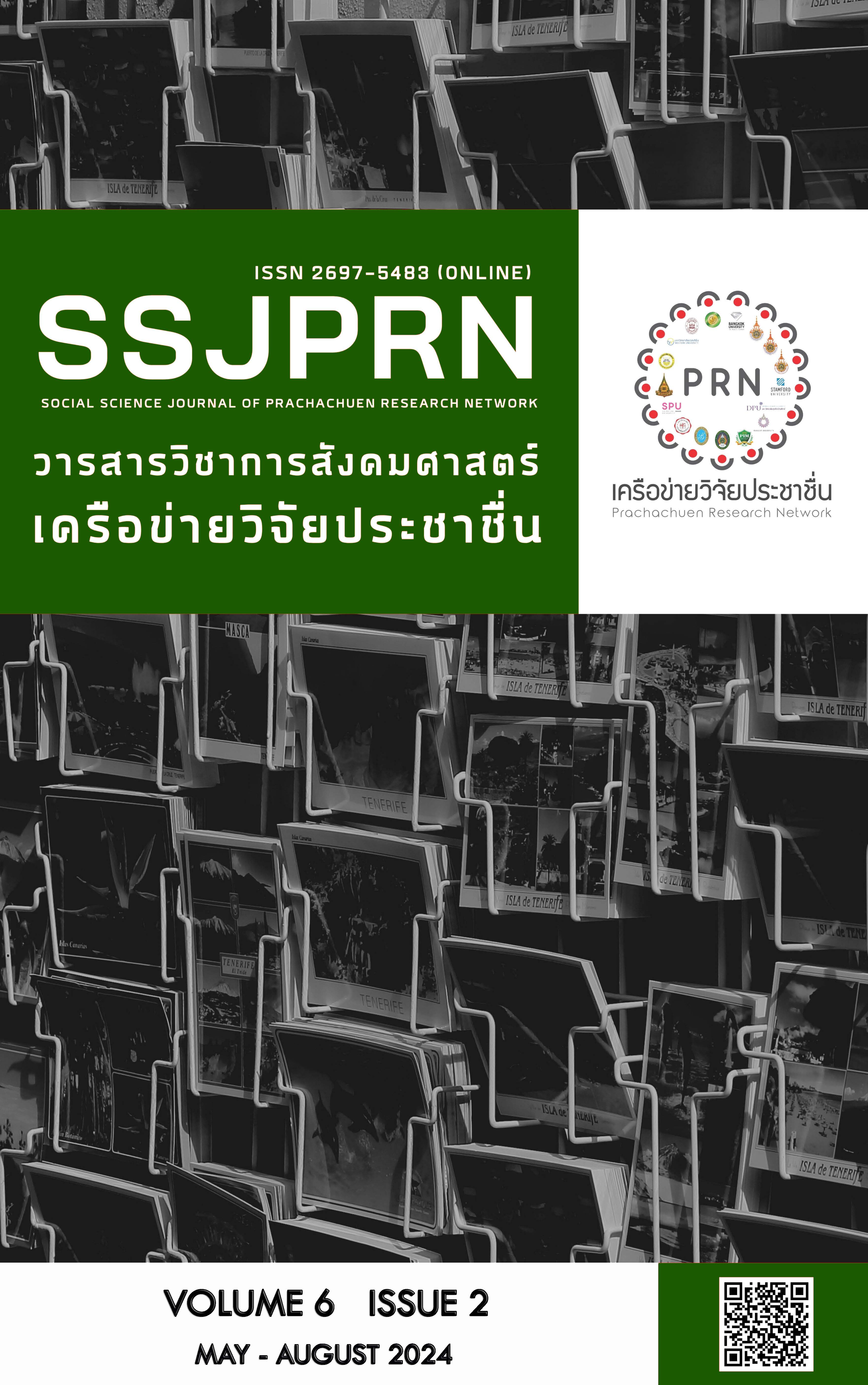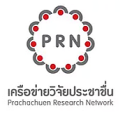ผลกระทบเชิงสาเหตุของการโฆษณา การประชาสัมพันธ์ และการส่งเสริมการขาย ต่อการตัดสินใจซื้อสินค้าบนแอปพลิเคชัน Pinduoduo ของผู้ใช้บริการ ในมณฑลซานตง ประเทศจีน ผ่านตัวแปรคั่นกลางการมีส่วนร่วมของลูกค้า
คำสำคัญ:
การโฆษณา, การประชาสัมพันธ์, การส่งเสริมการขาย, การตัดสินใจซื้อ, การมีส่วนร่วมของลูกค้าบทคัดย่อ
งานวิจัยนี้มีวัตถุประสงค์เพื่อศึกษาผลกระทบเชิงสาเหตุของการโฆษณา การประชาสัมพันธ์และการส่งเสริมการขายต่อการตัดสินใจซื้อสินค้าบนแอปพลิเคชัน Pinduoduo ของผู้ใช้บริการในมณฑลซานตง ประเทศจีน ผ่านตัวแปรคั่นกลางการมีส่วนร่วมของลูกค้า ประชากรที่ใช้ในการวิจัยนี้คือ ประชากรที่อาศัยอยู่ในมณฑลซานตง ประเทศจีน ที่เคยใช้บริการแอปพลิเคชัน Pinduoduo โดยมีขนาดกลุ่มตัวอย่าง 400 คน ด้วยวิธีการสุ่มแบบเจาะจง เก็บรวบรวมข้อมูลด้วยแบบสอบถาม และวิเคราะห์ข้อมูลด้วยค่าความถี่ ค่าร้อยละ ค่าเฉลี่ย และส่วนเบี่ยงเบนมาตรฐาน และทดสอบสมมติฐานด้วยแบบจำลองสมการโครงสร้าง
ผลการวิจัยพบว่า แบบจำลองสมการโครงสร้างมีความสอดคล้องกลมกลืนกับข้อมูลเชิงประจักษ์ โดยมีค่า Chi-square เท่ากับ 76.744 และ p-value เท่ากับ 0.071 Chi-square/df เท่ากับ 1.279 GFI เท่ากับ 0.981 AGFI เท่ากับ 0.935 NFI เท่ากับ 0.994 CFI เท่ากับ 0.999 และ RMSEA เท่ากับ 0.026 ผลการทดสอบสมมติฐานพบว่า การโฆษณา และการส่งเสริมการขายมีอิทธิพลเชิงบวกต่อการตัดสินใจซื้อสินค้าบนแอปพลิเคชัน Pinduoduo ของผู้ใช้บริการในมณฑลซานตง ประเทศจีน ผ่านการมีส่วนร่วมของลูกค้า อย่างมีนัยสำคัญทางสถิติที่ระดับ 0.001 โดยมีอำนาจในการพยากรณ์ร้อยละ 93.1 ซึ่งการมีส่วนร่วมของลูกค้าเป็นตัวแปรคั่นกลางอย่างสมบูรณ์ระหว่างการส่งเสริมการขายกับการตัดสินใจซื้อ แต่เป็นตัวแปรคั่นกลางบางส่วนระหว่างการโฆษณากับการตัดสินใจซื้อ
เอกสารอ้างอิง
กรมส่งเสริมการค้าระหว่างประเทศ. (2566). ส่องกลยุทธ์ฟื้นยอดขายของแพลตฟอร์มอีคอมเมิร์ซจีน. สำนักงานส่งเสริมการค้าในต่างประเทศ ณ เมืองชิงต่าว. https://www.foodtalks.cn/news/48383
กัลยา วานิชย์บัญชา และฐิตา วานิชย์บัญชา. (2558). การใช้ SPSS for Windows ในการวิเคราะห์ข้อมูล. โรงพิมพ์สามลดา.
คํานาย อภิปรัชญาสกุล. (2558). พฤติกรรมผู้บริโภค. โฟกัสมีเดียแอนด์พับลิชชิ่ง.
ฉลองศรี พิมลสมพงศ์. (2557). การวางแผนและพัฒนาตลาดการท่องเที่ยว (พิมพ์ครั้งที่ 12). สำนักพิมพ์มหาวิทยาลัยเกษตรศาสตร์.
ชูชัย สมิทธิไกร. (2562). พฤติกรรมผู้บริโภค (พิมพ์ครั้งที่ 7). สำนักพิมพ์แห่งจุฬาลงกรณ์ มหาวิทยาลัย.
ไทยรัฐออนไลน์. (2566). แอปฯ จีนอีกแล้วนะ! นักวิจัยพบ Pinduoduo สอดแนมข้อมูลผู้ใช้งานได้. https://plus.thairath.co.th/topic/everydaylife/102989
นเรศ เหล่าพรรณราย. (2561). ยุคที่รุ่งเรือง (กว่าเดิม) ของ E-Commerce แดนมังกร. http://www.bangkokbiznews.com/blog/detail/645783
ปิยะภัสร์ โรจน์รัตนวาณิชย์. (2561). วิธีการส่งเสริมการขายที่อยู่อาศัยของบริษัทพัฒนาอสังหาริมทรัพย์ที่จดทะเบียนในตลาดหลักทรัพย์แห่งประเทศไทย. สาระศาสตร์, 3, 435-447.
ไพศาล วรคำ. (2554). การวิจัยทางการศึกษา. โรงพิมพ์สามลดา.
ร่มฉัตร จันทรานุกูล. (2565). New China Insights: ‘พินตัวตัว’ แซง ‘เถาเป่า’ ขึ้นมาเป็นแอปขายของออนไลน์อันดับหนึ่งของจีนได้อย่างไร. https://mgronline.com/china/detail/9650000048273
ฤดี เสริมชยุต. (2563). กลยุทธ์การส่งเสริมการตลาด สำหรับการท่องเที่ยวชุมชน. วารสารสังคมวิจัยและพัฒนา, 2(4), 51-61.
วิรัตน์ เตซะนิรัติศัย. (2563). กลยุทธ์ทางการตลาดเพื่อรองรับมาตรฐาน ไทยแลนด์ 4.0. วารสารวิจัยมหาวิทยาลัยเวสเทิร์น มนุษยศาสตร์และสังคมศาสตร์, 6(2), 232-243.
ศิริวรรณ ปทุมสูติ. (2561). ส่วนประสมการตลาดและพฤติกรรมการซื้อรถยนต์นั่งส่วนบุคคลขนาดเล็กของผู้บริโภค ในเขตจังหวัดสุพรรณบุรี. วารสารวิทยาการจัดการ มหาวิทยาลัยราชภัฎนครปฐม, 5(1), 1-13.
สมิทธิ์ บุญชุติมา. (2561). การใช้เครื่องมือสื่อสารเพื่อการประชาสัมพันธ์ (การประชาสัมพันธ์ผ่านสื่อ กระจายภาพและเสียง อินเทอร์เน็ต และสื่อกิจกรรมพิเศษ). บริษัท 21 เซ็นจูรี่ จำกัด.
อำพล นววงศ์เสถียร, เขมรินทร์ ชูประดิษฐ์ และธรรมสรณ์ โมราวรรณ. (2562). ปัจจัยที่มีผลต่อการรับรู้แบรนด์ของสถาบันอุดมศึกษาเอกชนในบริบทสื่อสังคมออนไลน์ของนักศึกษาระดับประกาศนียบัตรวิชาชีพในจังหวัดสมุทรปราการ. วารสารการจัดการสมัยใหม่, 17(1), 147-161.
Adetunji, R. R., Nordin, S. M., & Noor, S. M. (2014). The implementation of integrated marketing communication (IMC) principles in branding and advertising: a conceptual exploration. New Media and Mass Communication, 21(2), 23-28.
Alalwan, A. A. (2018). Investigating the impact of social media advertising features on customer purchase intention. International journal of information management, 42, 65-77.
AsiaPac. (2022). อีคอมเมิร์ซจีน 2022. ข้อมูลเชิงลึกการตลาดดิจิทัล. https://www.asiapacdigital.com/th/digital-marketing-insight/china-ecommerce-2022
Belch, G. E., & Belch, M. A. (2015). Advertising and promotion: An integrated marketing communications perspective (7th ed.). McGraw-Hill Irwin.
Brodie, R. J., Hollebeek, L. D., Juric, B. & Ilic, A. (2011). Customer engagement: conceptual domain, fundamental propositions, and implications for research. Journal of Service Research, 14, 252-271.
CGTN. (2022). Digital economy becomes new growth engine for China and other G20 members. https://news.cgtn.com/news/2022-11-14/Digital-economy-turns-new-growth-engine-for-China-other-G20-members--1eWXYmrvcXe/index.html
Cheung, C. M., Shen, X. L., Lee, Z. W., & Chan, T. K. (2015). Promoting sales of online games through customer engagement. Electronic commerce research and applications, 14(4), 241-250.
Davis, A. (2013). Promotional cultures: The rise and spread of advertising, public relations, marketing and branding. Polity.
Fernandes, T., & Esteves, F. (2016). Customer engagement and loyalty: A comparative study between service contexts. Services Marketing Quarterly, 37(2), 125-139.
Hair, J., Black, W., Babin, B., & Anderson, E. (2010). Multivariate data analysis (7th ed.). Pearson Education Limited.
Henseler, J., Hubona, G., & Ray, P. A. (2016). Using PLS path modeling in new technology research: updated guidelines. Industrial management & data systems, 116(1), 2-20.
Henseler, J., Ringle, C. M., & Sarstedt, M. (2015). A new criterion for assessing discriminant validity in variance-based structural equation modeling. Journal of the academy of marketing science, 43, 115-135.
Hill, D. (2010). About face: the secrets of emotionally effective advertising. Kogan Page Publishers.
Hollebeek, L. D., Conduit, J., & Brodie, R. J. (2016). Strategic drivers, anticipated and unanticipated outcomes of customer engagement. Journal of Marketing Management, 32(5-6), 393-398.
Kaihatu, T. S. (2020). Purchase intention of fashion product as an impact of digital marketing, mediated by customer engagement in the generation z. Jurnal Manajemen Pemasaran, 14(2), 61-66.
Kannan, P. K. (2017). Digital marketing: A framework, review and research agenda. International Journal of Research In Marketing, 34(1), 22-45.
Khan, I., Rahman, Z., & Fatma, M. (2016). The role of customer brand engagement and brand experience in online banking. International Journal of Bank, 34(7), 1025-1041.
Kotler, P., & Keller, K. L. (2016). Marketing management (15th ed.). Education, Inc.
Kumar, V., & Pansari, A. (2016). Competitive advantage through engagement. Journal of Marketing Research, 53(4), 497-514.
Ogden-Barnes, S., & Minahan, S. (2015). Sales promotion decision making: concepts, principles, and practice. Business Expert Press.
Price Waterhouse Coopers. (2013). A new era in buying retail in China’s digital age. https://www.pwccn.com/en/consulting/consulting-retail-china.pdf
Quesenberry, K. A. (2020). Social media strategy: Marketing, advertising, and public relations in the consumer revolution. Rowman & Littlefield Publishers.
Smith, P. R., & Zook, Z. (2024). Marketing communications: Integrating online and offline, customer engagement and digital technologies. Kogan Page Publishers.
Thakur, R. (2016). Understanding customer engagement and loyalty: A case of mobile devices for shopping. Journal of Retailing and consumer Services, 32, 151-163.
ดาวน์โหลด
เผยแพร่แล้ว
รูปแบบการอ้างอิง
ฉบับ
ประเภทบทความ
สัญญาอนุญาต
ลิขสิทธิ์ (c) 2024 วารสารวิชาการสังคมศาสตร์เครือข่ายวิจัยประชาชื่น

อนุญาตภายใต้เงื่อนไข Creative Commons Attribution-NonCommercial-NoDerivatives 4.0 International License.
บทความที่ได้รับการตีพิมพ์เป็นลิขสิทธิ์ของวารสารวิชาการสังคมศาสตร์เครือข่ายวิจัยประชาชื่น







